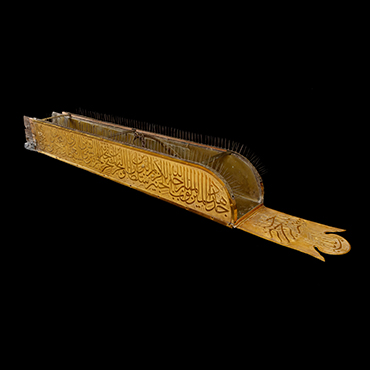The Spout of Mercy
وَنَزَّلۡنَا مِنَ ٱلسَّمَآءِ مَآءٗ مُّبَٰرَكٗا
Holy Qur’an, chapter Qaf (50:9)
Allah describes the rain He sends as “blessed”. Befittingly, this rainspout from the roof of the Ka‘bah is known as the Spout of Mercy.
This mizab (spout) takes water that would otherwise collect on the Ka‘bah’s flat roof and projects it away from the walls, onto the Hijr Isma‘il below (a semi-circular wall opposite the north-west wall of the Ka‘bah, known as the hatim). This could be either rainwater or excess water from the ritual cleaning of the Ka‘bah, which traditionally used a mixture of rosewater and water from the sacred Zamzam Well.
The earliest record of a spout dates from when the Quraish first added a roof to the Ka‘bah. Since AH 91/709–10 CE, the tradition has been for the spout to have gold or gilded plaques. This spout has solid gold plaques pinned onto a teak boxing lined with lead. The pointed spikes were designed to prevent birds from sitting on the spout and fouling the water.
The spout was commissioned by Sultan Abdulmajid I in AH 1273/1856–7 CE to replace a spout put up almost 250 years earlier.
A recently discovered archival document identifies the calligrapher as Abdullah al-Zuhdi, who was responsible for the inscriptions on the mihrab wall of the Prophet’s Mosque in al-Madinah al-Munawwarah.
Water spout of the Ka‘bah (mizab)
Istanbul, Türkiye
AH 1273/1856–57 CE
Calligraphy by Abdullah al-Zuhdi, patronised by Sultan Abdulmajid I
Installed on the Ka‘bah in AH 1276/1859–60 CE
Teak, gold, lead
The General Authority for the Care of the Two Holy Mosques

